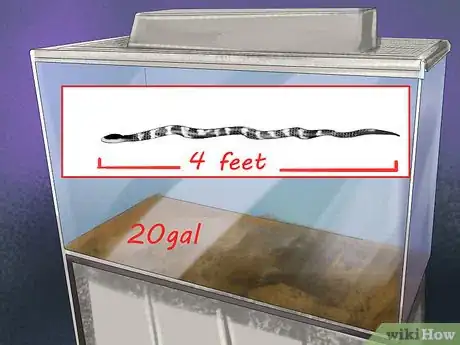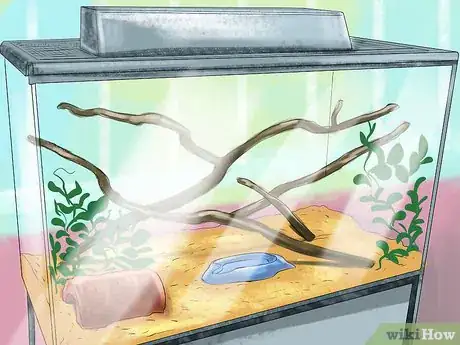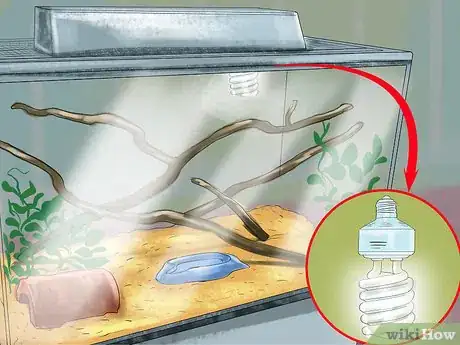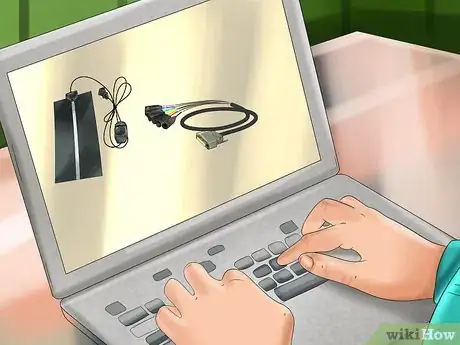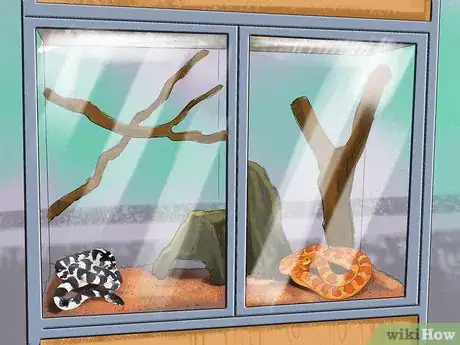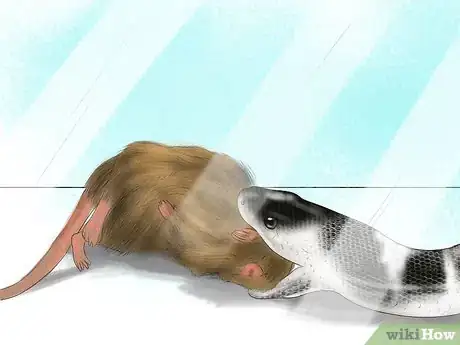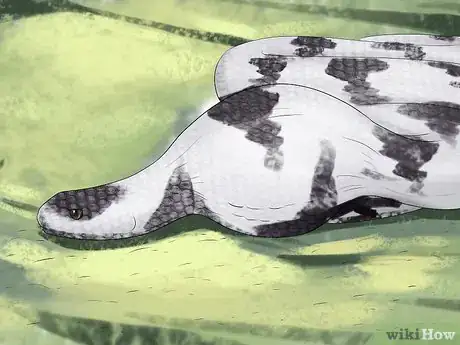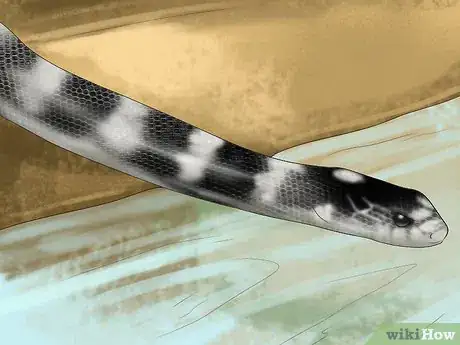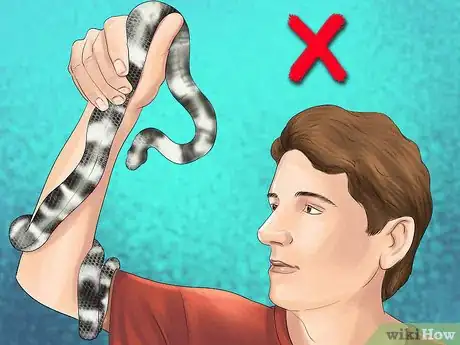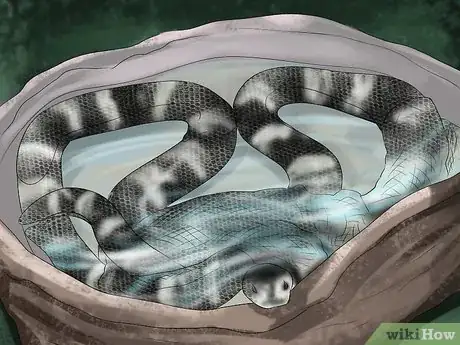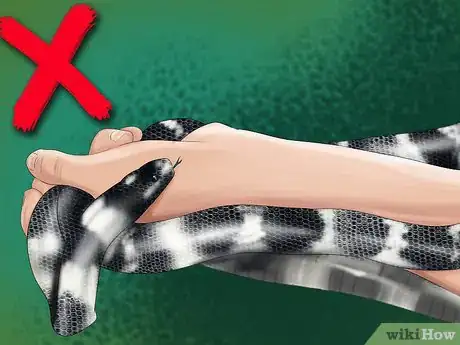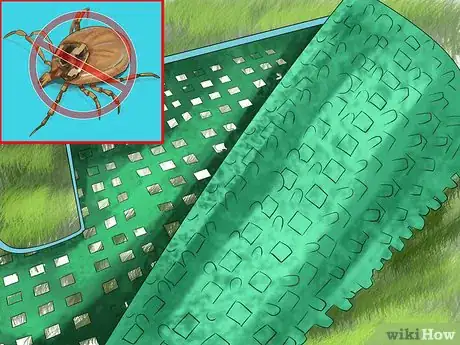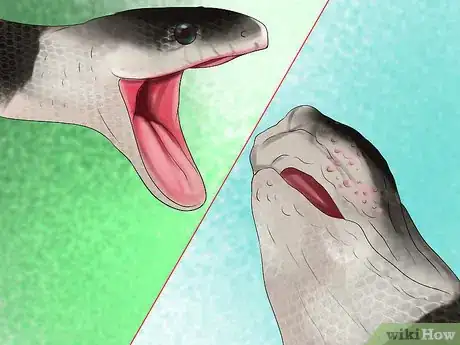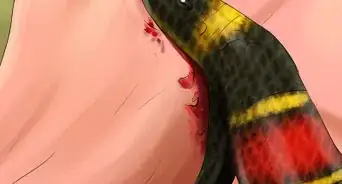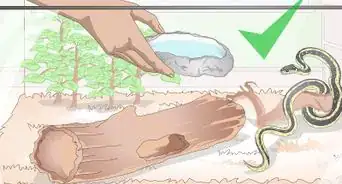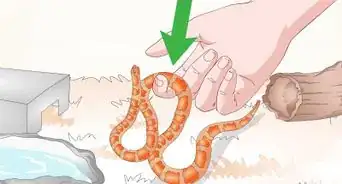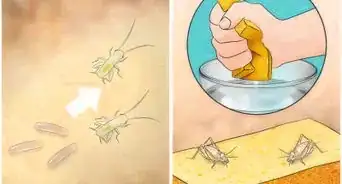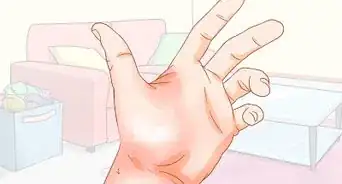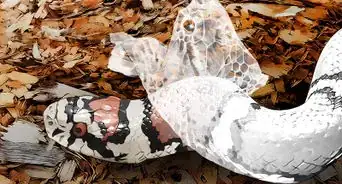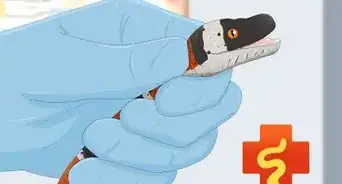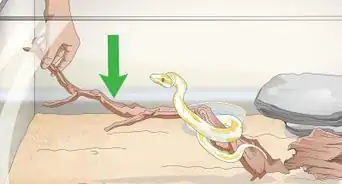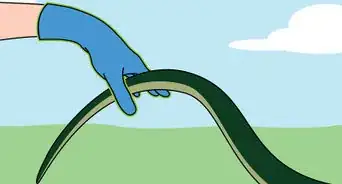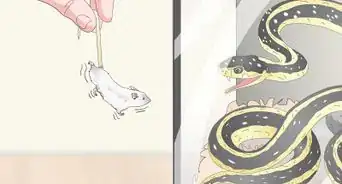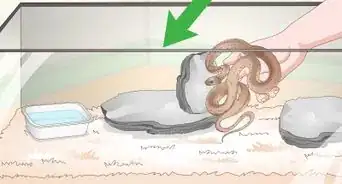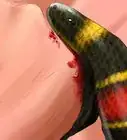This article was co-authored by Pippa Elliott, MRCVS. Dr. Elliott, BVMS, MRCVS is a veterinarian with over 30 years of experience in veterinary surgery and companion animal practice. She graduated from the University of Glasgow in 1987 with a degree in veterinary medicine and surgery. She has worked at the same animal clinic in her hometown for over 20 years.
wikiHow marks an article as reader-approved once it receives enough positive feedback. In this case, 84% of readers who voted found the article helpful, earning it our reader-approved status.
This article has been viewed 83,125 times.
California king snakes are one of the best beginner snakes to keep. They are low maintenance, very rarely bite, and don't mind being handled. If you’re considering getting one, be sure that you have adequate space for a habitat and adequate time to feed and water your snake.
Steps
Setting Up a California King Snake’s Habitat
-
1Buy a habitat. Choose a clear glass terrarium or similar container.[1] Though California King Snakes usually only get about 4 feet long, some can reach an adult length of 6 feet, so you should get a habitat that can accommodate your snake at its largest possible size.[2]
- If your snake lays around the edge of the tank and doesn’t cover more than 2/3 of the distance around the perimeter, the tank is probably big enough.
- Bigger is better. The more room you can give your snake to crawl around, the happier it will be.
- Most adults need about a 20-gallon enclosure or larger.
-
2Secure the habitat. Be sure that the enclosure is completely escape-proof. If there is any weakness in the structure at all, your California King Snake will find it and get out.[3]Advertisement
-
3Add a viewing light. If you want to be able to see your snake better, you can add a standard florescent bulb to the habitat, or just put a light nearby. You don’t need any kind of special lighting in the tank.[4]
-
4Provide a warm end and a cool end. Since snakes are “cold blooded,” they quickly become the temperature of their surroundings. You can buy heaters, pads, or cables (online or in a pet shop) for this purpose. Try to make the warm end stay around 85 degrees F and the cool end stay around 70 degrees F.[5]
- Don’t put the habitat near a window with direct sun. It can become too hot very quickly, and your snake will die.
- Some people use lights to heat one end of the tank, but this doesn’t always work well. It requires a lot of energy, and lights often heat the air but are ineffective at heating the floor of a tank.
- Never use “hot rocks.” They can cause burns.
-
5Cover the floor of the habitat. You can purchase commercial substrates or use newspaper, paper towels, or indoor carpet. Don’t use cat litter or anything chemically treated or oily. Avoid anything that has an odor.[6]
- If your snake can’t burrow into the floor covering of your choice, provide a few places for it to hide inside the tank so that it feels secure. You can use half-logs, cork, or pieces of grapewood.[7]
-
6Add climbing structures. If you want, you can add a few branches or other structures for your snake to climb on and hang from. These aren’t strictly necessary, but they’ll make your tank more interesting for both you and your California King Snake.[8]
Caring for Your California King Snake
-
1House your snakes alone or together only when breeding. Never keep them in a habitat with other kinds of snakes. Don’t keep juvenile King Snakes in the same habitat, because they might eat each other. California King Snakes should be kept in their enclosures alone so they feel safe, comfortable, and don't have to compete for food.[9]
- Only keep King Snakes together if you have decided to breed them.
- Make sure to do your research before breeding so you don't accidentally put your animals at risk.
- Watch them carefully for signs of aggression.
- Do not keep King Snakes together after breeding has occurred.
-
2Feed your snakes alone. Never feed two King Snakes in the same habitat. Separate them for a few minutes before they eat to avoid food aggression, and then keep them apart for several hours after they’ve finished.[10]
-
3Feed your snake mice. Live mice are fine, but they’re not required, and they can often wound your snake. Freshly killed mice are the best choice, but if you want to freeze some for convenience, it’s okay to give your snake a very well-thawed one.[11]
- One mouse per week will be enough, but if you want your snake to grow faster, you can give it up to two per week. Once they’re fully grown, in order to avoid obesity, you may need to cut back to once a week.
- When your snake is a baby, feed it newborn mice (about the size of your pinky). Increase the size of your mice as your snake grows. The largest adult snakes can often handle a small rat instead of multiple mice.[12]
- You can usually buy mice at your local pet store, but you can also order them online.
-
4Stay away from your snake until the lump from the mouse disappears. Don’t pick your snake up until it has digested the mouse enough that the lump in its middle has disappeared, because it might still feel aggressive before its food is digested.[13]
-
5Provide fresh water. Use a relatively deep bowl. Sometimes King Snakes like to take a soak in their water bowl, so fill it up only about halfway to prevent them from spilling the water over the edges. Check the water bowl every day, and keep it clean. [14]
- If the habitat starts to feel very moist, take the water bowl out and only put in for a few days every week.
-
6Handle your snake gently. Remember that this is a wild animal, so it may be afraid of you for quite some time. Hold your snake gently, and stay away from its face, especially at first. Start with just a few minutes of handling once a week and work your way up. [15]
- It’s not unusual for king snakes to defecate or urinate on you when you handle them, especially at first.
- If you notice that your snake’s behavior or appetite changes suddenly, it could be because it’s stressed from too much handling.
-
7Watch for shedding. Don’t handle your snake when it’s getting ready to shed. You’ll know this is happening when their skin starts to turn milky or bluish. In a few days, they’ll crawl completely out of their old skin, and it will be safe to hold them again.[16]
- Particularly around the time when they’re shedding, King Snakes will enjoy an occasional mist of water all over their tank. Any plastic or glass spray bottle will work.[17]
-
8Don’t restrain your snake. California King Snakes almost never bite, but if you restrain them, they may. Never pinch or squeeze them. Let them flow gently through your hands and fingers. Don’t let them dangle unsupported.[18]
Keeping an Eye Out for Common Problems
-
1Find a vet who knows about snakes. Most vets don’t come in contact with snakes that often; they tend to have a lot more experience with animals like dogs and cats. You may have to travel to find a competent vet, so it’s a good idea to get acquainted with one before anything goes wrong so you can call them if you have questions.[19]
- There are a variety of vet locators online. Try kingsnake.com to find one who works with King Snakes regularly.
-
2Watch for mites. These tiny black parasites love to live on King Snakes. Keep an eye out especially around their eyes, mouth, and under their scales. If you notice that your snake is lethargic or not eating, mites may be the cause, so give them a good inspection.[20]
- To get rid of mites, bathe your snake in warm water. Disinfect everything in the tank and provide fresh flooring.You may want to wait a while to put any “furniture” back in the tank, because you will be more likely to see mites if they don’t have a lot of hiding places.
- If a good cleaning and disinfection doesn’t get rid of the mites, talk to someone at your local pet store or ask your vet about possible products to get rid of stubborn infestations.
-
3Keep an eye out for respiratory infections. If your King Snake sounds wheezy or has excessive saliva, it may have a respiratory infection (caused by a dirty cage, low temperatures, or contact with another infected snake). If the problem persists for more than a day or two, or if you feel alarmed, call your vet. Your King Snake may need an antibiotic.[21]
-
4Pay attention to regurgitation. It’s not uncommon for snakes to regurgitate part of their meal after they eat it, but since this may be a sign of serious illness, you should keep an eye on your snake for other symptoms if you see them do this. If it happens repeatedly or your snake starts to lose weight, it’s time to take it to the vet.[22]
- One common reason that snakes regurgitate their meals is that their owners pick them up too soon after they eat. Try to avoid this, particularly if your snake is have a regurgitation problem.
References
- ↑ http://www.lllreptile.com/articles/56-california-king-snake
- ↑ http://www.reptilesmagazine.com/Care-Sheets/Snakes/California-Kingsnake/
- ↑ http://www.reptilesmagazine.com/Care-Sheets/Snakes/California-Kingsnake/
- ↑ http://www.lllreptile.com/articles/56-california-king-snake
- ↑ http://www.reptilesmagazine.com/Care-Sheets/Snakes/California-Kingsnake/
- ↑ http://www.reptilesmagazine.com/Care-Sheets/Snakes/California-Kingsnake/
- ↑ http://www.lllreptile.com/articles/56-california-king-snake
- ↑ http://www.lllreptile.com/articles/56-california-king-snake
- ↑ http://www.reptilesmagazine.com/Care-Sheets/Snakes/California-Kingsnake/
- ↑ http://www.reptilesmagazine.com/Care-Sheets/Snakes/California-Kingsnake/
- ↑ http://www.reptilesmagazine.com/Care-Sheets/Snakes/California-Kingsnake/
- ↑ http://www.lllreptile.com/articles/56-california-king-snake
- ↑ http://www.reptilesmagazine.com/Care-Sheets/Snakes/California-Kingsnake/
- ↑ http://www.reptilesmagazine.com/Care-Sheets/Snakes/California-Kingsnake/
- ↑ http://www.reptilesmagazine.com/Care-Sheets/Snakes/California-Kingsnake/
- ↑ http://www.reptilesmagazine.com/Care-Sheets/Snakes/California-Kingsnake/
- ↑ http://www.thekingsnake.co.uk/common_king_snakes_care_sheet.htm
- ↑ http://www.vmsherp.com/CarePages/CareCalKing.htm
- ↑ http://www.kingsnake.com/vets.html
- ↑ http://www.thekingsnake.co.uk/common_king_snakes_care_sheet.htm
- ↑ http://www.thekingsnake.co.uk/common_king_snakes_care_sheet.htm
- ↑ http://www.thekingsnake.co.uk/common_king_snakes_care_sheet.htm
About This Article
To keep a California king snake, keep it in a tank that's at least 20 gallons, and line the bottom of the tank with a substrate for your snake to burrow in. You should also add a few branches or other structures so your snake has things to climb on. Also, use a heater to heat one side of the tank to 85 degrees so there's a warm end and a cool end for your snake. To feed your snake, give it 1 live or recently-killed mouse per week. For more advice from our Veterinary co-author, like how to handle your California king snake, read on!
